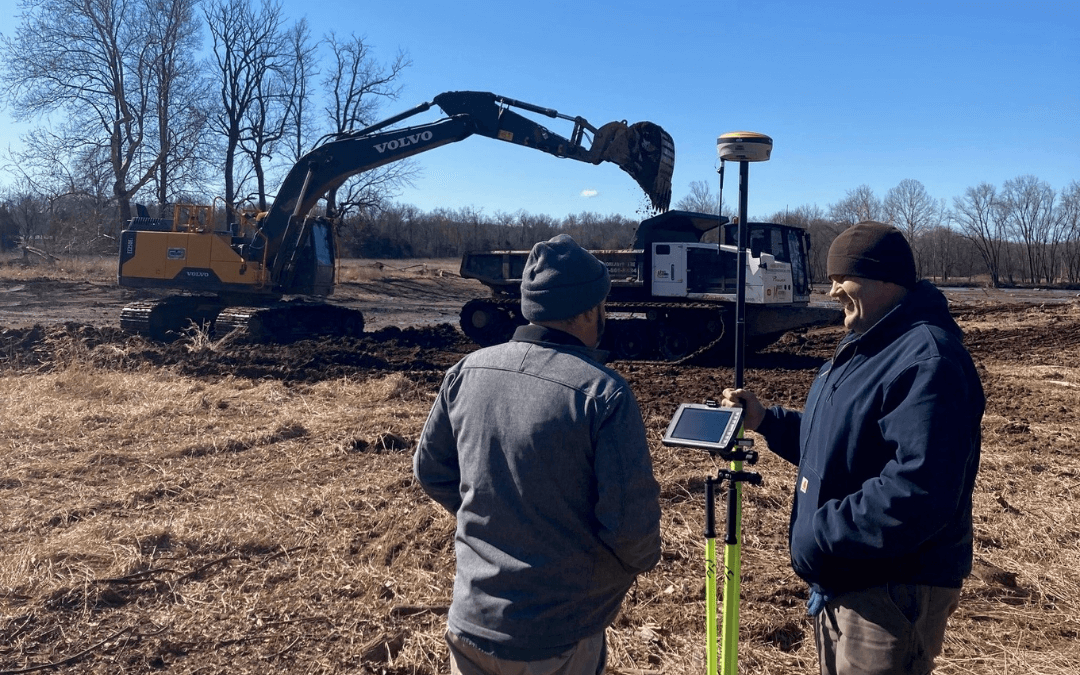Some excavation and construction teams still rely on outdated methods to survey and excavate their job sites. Innovative companies, however, are taking advantage of the latest total station technology to cut down on work time and dig with unprecedented precision. Recently, we decided to make some advancements in technology and acquire our first excavator with GPS technology as well as total station equipment. It has been a game-changing addition to how we do our work, helping us make on-site decisions with confidence — and lessen our impact on the environment too.
What Is Total Station Equipment?
A total station is made up of four elements: EDM (electronic distance measurement), an electronic theodolite, a microprocessor, and an electronic display. The equipment relies on GPS technology to provide precise topographic data and create a virtual model of a job site. Excavator operators then use the virtual model to determine the exact depth, location, and angle of each dig.
Flyway uses total station equipment manufactured by Hemisphere, one of the leading manufacturers of GPS products worldwide. We chose the Hemisphere C631 GNSS Smart Antenna because it is the same system used in our Volvo excavator. Volvo calls this their Dig Assist program, which is well-known for its ability to collect more accurate information over extreme distances and instantly import the gathered data onto a computer for analysis. It allows an operator to be extremely precise when performing any type of excavation.
How Does Total Station Equipment Work in the Field?
Digging a trench for something like a retaining wall or drainage system typically requires on-site guidance from a surveyor on the shape and contour of the ground, as well as from the engineer who created the project’s plans, to achieve precision. However, using total station equipment can minimize how much of this guidance is needed.
In Flyway’s case, we take an engineer’s plans and upload them to a tablet attached to our total station. The combination of this tablet and the C631 GNSS Smart Antenna is called a rover because it is attached to a bipod that can be walked all around a job site to check the grades and elevations. It receives GPS information from our base station, which is another smart antenna that sits on a tripod. We then look at the data from the rover and see how it compares to the plans.
We also upload the engineer’s plans to a tablet in the excavator cab. It has the Hemisphere software preloaded, which lets the operator see the plans as well as the specific area in which they’re working. The total station keeps the operator informed of how close they are to reaching the proposed finished grade, which helps to eliminate guesswork that can lead to mistakes, or manual checks that require additional field personnel.
What Makes Total Station Equipment Special?
It allows excavators to rely less on surveyors and engineers in the field. Not having to wait for their guidance speeds up the rate at which a project can be completed.
Programs like Dig Assist increase the skill level of even the most beginner operator, decreasing the chance of over- or under-excavating. Precise excavation results in less machine run time (and therefore fewer greenhouse gas emissions as well) to make up for these errors. Total station equipment also decreases the number of staff needed in the field, reducing cost for the owner and allowing us to complete more projects.
Not only does total station equipment save time and help excavators minimize their impact on the environment, but it also levels the playing field for small contractors and excavating companies like Flyway. With the advanced technology, we can confidently tackle complex jobs typically done by larger crews.
Why We’ve Invested in Total Station Technology
Innovations in total station equipment have been a game changer for excavating companies. The technology provides invaluable data, speeds up workflow, and ensures precision in the final outcome. Without total station equipment, jobs can take more time, require more workers, and suffer more mistakes, leading to longer timelines and more greenhouse gas emissions.
Flyway Excavating is committed to getting the job done right in the most eco-friendly manner possible. To learn more about our services, or to team up on your next waterway or construction project, contact us. We look forward to partnering with you to improve our environment together.
